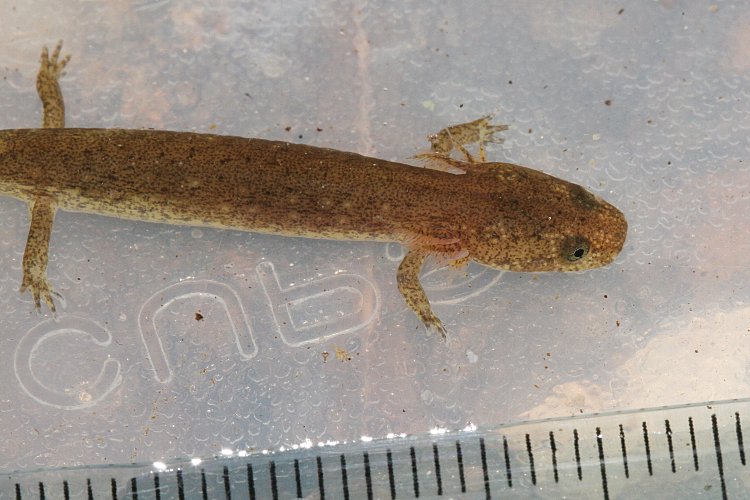
Larva #1, 45 mm total length, found 16 March 2008. What am I?
In the spring of 2008 I collected and raised five Pseudotriton larvae in southeast Ohio. In this part of the state, both the Red Salamander (Pseudotriton ruber) and the Mud Salamander (Pseudotriton montanus) occur. The identification of the larval forms of these species can be rather challenging. I have seen several dozen larvae of these species over the previous few years and have developed a "feel" for identifying them. What this really means is that most of the time I was pretty sure what species they were. However, I like certainty.
The adult Red and Mud Salamanders can be identified (nearly) unambiguously. A "brute force" approach to identifying the larvae is thus to maintain them in captivity until they transform -- at which point the species identity should be clear; hence my motivation for this project. I am not the first person to do this -- Ralph Pfingsten and probably others have done this previously.
Another complicating factor with these species is that they are often extremely difficult to find, due to their secretive habits. Throughout these species distributions in the eastern United States, there is a tendency for P. montanus to utilize lowland habitats and for P. ruber to be found in upland habitats. While these species tend to follow this pattern in southeast Ohio to some degree, it is by no means an absolute rule. At some localities, I have found an adult or two (mostly by luck) and do not have the faintest idea how to find the larvae. At other localities, I have found the larvae but have never seen an adult. There are just a few localities where I have seen both adults and larvae. The details of the distributions of these species in southern Ohio remain rather uncertain. In some areas, both species occur, even microsympatrically. In other areas, it is one or the other. And of course a lack of records tends to be the rule -- neither species has been recorded from the vast majority of townships in southern Ohio. In addition, the Mud Salamander is at the northern limit of its distribution in southern Ohio -- the precise northern limit of its range is thus also an interesting question.
The five Pseudotriton larvae that I collected were all from different localities where these species had not been previously recorded. The primary goal of this project was to establish with certainty the species identity of these animals. I was also interested in photographically documenting their development. I have found that having photographs available of animals of unquestionable identity is very helpful for identifying other animals. I hope that others will find this information interesting as well.
The salamanders are described by the labels #1, #2, #3, #4, and #5. Detailed information about each salamander and links to photographs are given in the summary at the end of this document.

Larva #1, 45 mm total length, found 16 March 2008. What am I?
The larvae were obtained by dipnetting in March, April, and May
of 2008. They were maintained separately in 5.5" X 5.5" x 2"
plastic containers filled with approximately 1" of water and
with a couple of dead leaves as shown:
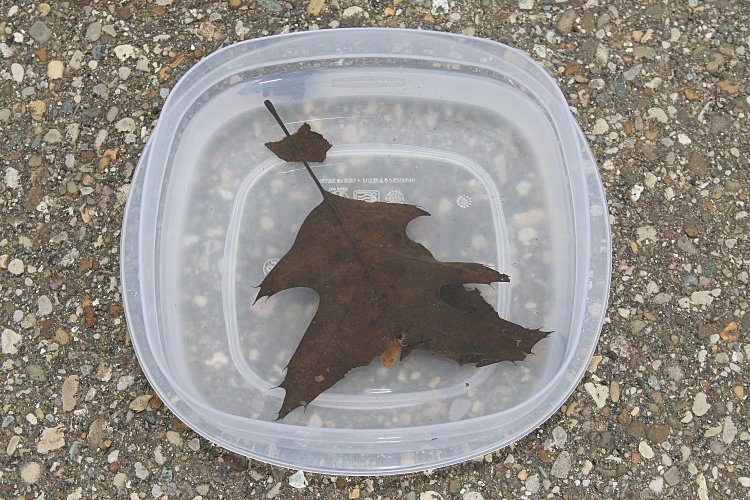
Larva #2 in its container on 17 May 2008.
Approximately 70% of the water was changed weekly, using aged
Athens city water of approximately the same temperature as
the original water. The containers were kept closed:
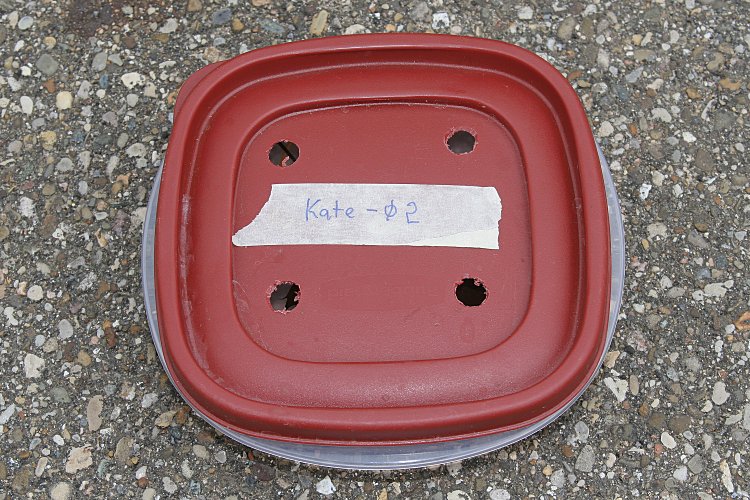
The container of Larva #2, with lid.
Initially, the larvae were kept on a workbench in my garage.
In March, the water temperature was approximately 50°F.
However, by late May the temperature was measured as high
as 70°F. At this higher temperature, larvae #1 and #2
behaved normally and continued to feed, but larva #3 showed
some indication of distress -- it would not feed (larvae #4 and #5
had not yet been collected). At this point all of the larvae were
placed in a small wine fridge where they were maintained at
55°F for the remainder of the larval period:

The Haier "Countertop Thermal Electric Wine Cellar" (model #HVUEB06B)
costs about $60 from Lowes.
It proved to be nearly perfect for this job. It displays the
current temperature in °F and the thermostat could be set
to any temperature between 46°F and 64°F (the readout and
thermostat setting could also be done in °C if you like).
It could hold up to 8 of the above plastic containers. The only minor
down side is that it would default to the minimum temperature setting
of 46°F whenever there was a power glitch. This happened about
10 times. Sometimes I didn't catch it for a day or two -- the salamanders
didn't seem to mind an occasional cold spell.
Also shown in the photo above is a digital thermometer. It was very handy for several things, for example testing the temperature of the water used for water changes and for verifying that the wine fridge was working as advertised.
Initially, I fed the larvae live earthworms -- either worms which were small enough to eat or pieces of worms. I soon switched to live blackworms (Lumbriculus variegatus) that were available from a local pet store. They proved easier to deal with than earthworms, as small earthworms were sometimes troublesome to find. The larvae were fed every other day. I would put 2-3 blackworms into their container at a time and watch the larvae until they ate them (or not). I never left them with food for an extended period of time. A typical feeding would consist of 6 blackworms per larva, but it varied from zero up to 12. The larvae appeared to be attracted by movement of their food. They would always touch the worm with their lips before eating it, as if to "taste" it. The worms were ingested via a sudden suction generated by the larva's gills (think inhalation). A large worm might require 2-3 separate "sucks".
All five larvae transformed into terrestrial salamanders in the late spring and/or summer. The details for each salamander are presented in the summary at the end of this document. For both species, transformation was marked by several external changes:
The salamanders were observed to shed their skin with increased frequency during transformation. The changes in the eyes perhaps warrant further comment. The surfaces of the eyes of larval Pseudotriton are nearly flush with the contours of their head, perhaps to aid in burrowing into their substrate. The eyes of the transformed salamanders, on the other hand, protrude significantly from the head, producing a pop-eyed appearance. There are also some changes in the color of the eyes, which depend upon the species: the eyes of transformed P. montanus are dark brown, while those of P. ruber are golden, with a dark horizontal bar.
All of the larvae ceased to feed fairly early in the transformation process. Just prior to the complete cessation of feeding, it appeared that they had some difficulty ingesting the blackworms. In some cases the blackworms went in their mouth and out of their gill slit. The fasting period during transformation was observed to be 6-8 weeks in duration (see the summary section below).
The salamanders did not appear to grow in length during the transformation process. In fact, they may have even lost a millimeter or two of length, due to the absorption of the tail fin.
As the salamanders progressed through the transformation process, I
lowered the water level and added some stones so that the salamanders
could crawl out of the water if they wanted. Once they appeared to
be completely transformed, I reduced the water level to about 1 mm.
The containers were raised in the center so the water was mostly
confined to the perimeter. I also added a folded paper towel to retain
some moisture, as shown below. The containers required cleaning 2-3 times
per week. I kept the containers simple so that I could monitor their
food consumption. The salamanders often hid themselves between the
layers of the paper towel. They were also often found to have moved
the stones in their containers around.
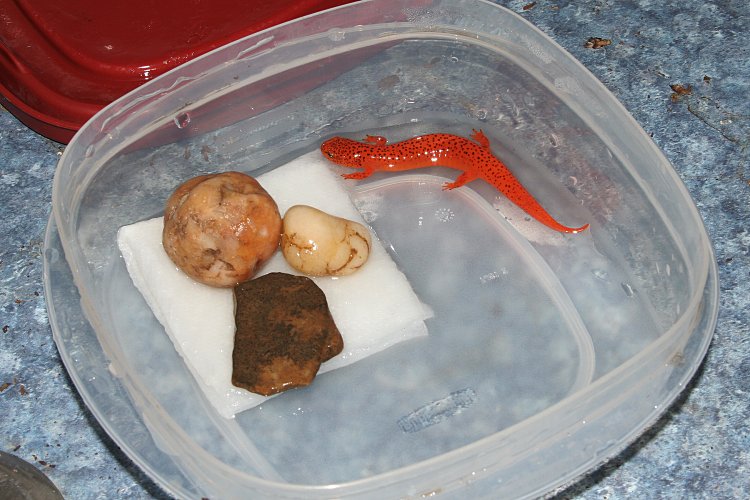
Salamander #3 in its container.
These salamanders are excellent climbers. Salamander #5 escaped from its container through the holes in the lid (the same size holes as in the container for Larvae #2 shown above). Fortunately, I found it inside the refrigerator, none the worse for wear. Needless to say, I switched to lids with smaller holes!
The transformed salamanders were primarily fed using earthworms of all sizes: from very small ones which they could swallow hole to small pieces of large "nightcrawlers" sold as fish bait. They also were fed blackworms, scuds, dead house flies, and pieces of shrimp (purchased from the supermarket). Although the salamanders did appear to be attracted by the movement of live prey, they did not hesitate to eat dead food. Like the larvae, they were always observed to "taste" their food with their lips before taking it in their mouth. I also found the transformed salamanders to be more shy about eating in the light while being watched than the larvae were. It appeared that their willingness to eat while being observed depended upon how hungry they were (i.e., how long it had been since they had been fed). I typically left them with food all of the time, noting the number of food items so that feeding could be monitored. The salamanders were usually provided with fresh food every other day, but sometimes the period between feedings was as long as a week.
The total lengths (TL) of the salamanders were determined periodically
by photographing them next to a ruler.
The effects of parallax were minimized by using a
camera lens with a fairly long focal length (100 mm) and by using camera
angles close to perpendicular to the container. The measurements were
extracted from the digital photographs on a computer monitor by using
a piece of paper to measure the length of the salamander and then measuring
the length against the ruler. If the salamander had some curvature in its
body posture, the paper could be used to trace that curve. With the
transformed salamanders, there was sometimes difficulty in getting them to
pose in a reasonably straight posture. By performing repeated measurements
of the same salamander in different positions, and testing for parallax
by including multiple rulers in one photograph, I estimate the
uncertainty of the measurements to be 2%.
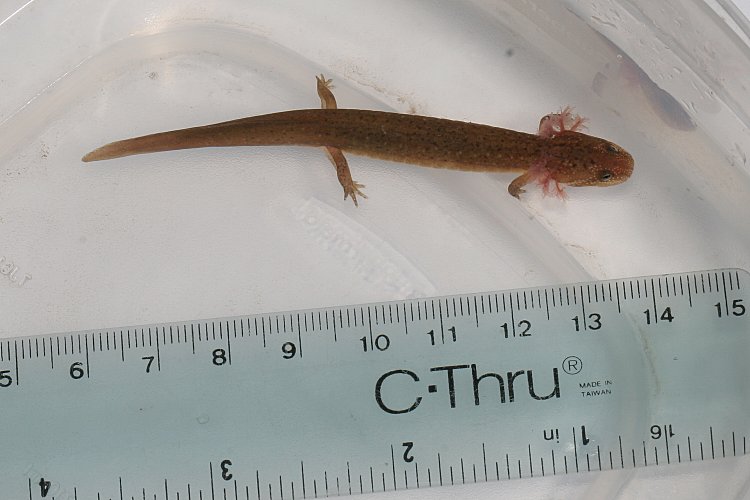
Photograph used to determine TL=79 mm for Larva #3 on 1 June 2008.
Some specific details of the five salamanders are shown in the table below.
| salamander | #1 | #2 | #3 | #4 | #5 |
|---|---|---|---|---|---|
| collection date | 16 March 2008 | 29 March 2008 | 27 April 2008 | 18 May 2008 | 31 May 2008 |
| last larval feeding | 27 May 2008 | 15 May 2008 | 29 June 2008 | 14 June 2008 | 29 June 2008 |
| first post-transformation feeding | 18 July 2008 | 4 July 2008 | 18 August 2008 | 6 August 2008 | 2 September 2008 |
| TL at collection | 45 mm | 54 mm | 74 mm | 74 mm | 72 mm |
| 17 May 2008 TL | 66 mm | 64 mm | 78 mm | - | - |
| 1 June 2008 TL | 66 mm | 63 mm | 79 mm | 80 mm | - |
| 7 July 2008 TL | 66 mm | 66 mm | 84 mm | 80 mm | 73 mm |
| 20 August 2008 TL | 73 mm | 67 mm | 84 mm | 81 mm | 71 mm |
| 2 November 2008 TL | 84 mm | 81 mm | 89 mm | 85 mm | 74 mm |
| 7 January 2009 TL | 93 mm | 87 mm | 92 mm | 87 mm | 79 mm |
One interesting observation is that the "fasting period" while the salamander was transforming was observed to be about 6-8 weeks in duration. As described above, this was for a temperature of 55°F.
Here are links to photographs of the development of the five salamanders over time:
I have purposefully refrained from providing their species identity at this point, in case some people would like to put their identification skills to the test. The answers are given at the end of each of the five pages linked above. As you progress through each page, the answer should become more apparent as the larva ages and transforms.
After transformation, the salamanders continued to grow. In addition, the background color for both species became a darker shade of red/orange and the sizes of the black spots increased.
Below, I summarize my thoughts on characteristics that may be useful for identifying these species in the larval stage. These comments are based upon my experience with the species, original literature, and communications with others experienced with these species. Some important points to remember: (1) the identification of larvae is easier the closer they are to transformation, (2) it is dangerous to rely on a single characteristic as there may be variation (particularly for some characteristics), and (3) these may not be applicable outside of southeast Ohio. As is always the case with species comparisons and/or identifications, determinations are much easier if several examples of both species are in hand.
Of the above characteristics, the gills and eyes are most likely to be useful for younger larvae. The body and head patterns and the size are most likely to be helpful for mature larvae.
There are undoubtedly additional useful characteristics for distinguishing Pseudotriton larvae. An extensive analysis of 12 morphological characteristics of Pseudotriton larvae from the southeastern United States has been presented by Birchfield and Bruce (2000, see reference section below). It is also possible that experienced observers may be able to intuitively integrate many characteristics to arrive at an identification by gestalt.
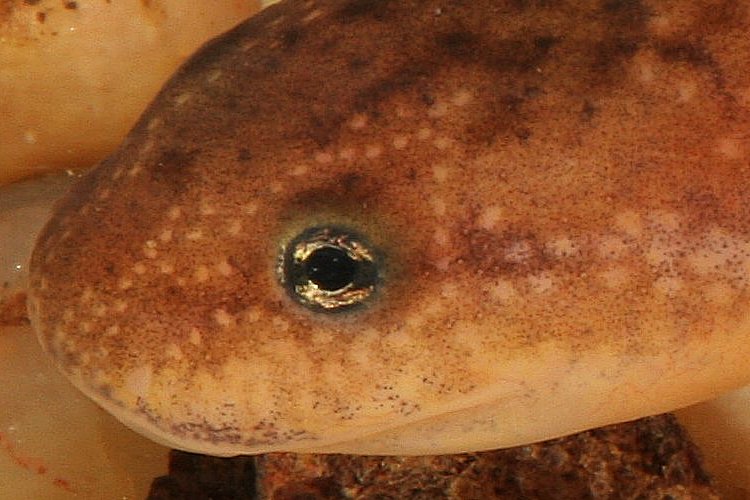
Head of an 81-mm TL Pseudotriton ruber larva. Note the dark horizontal
bar through the iris and the dark pigment developing on the
upper lip.
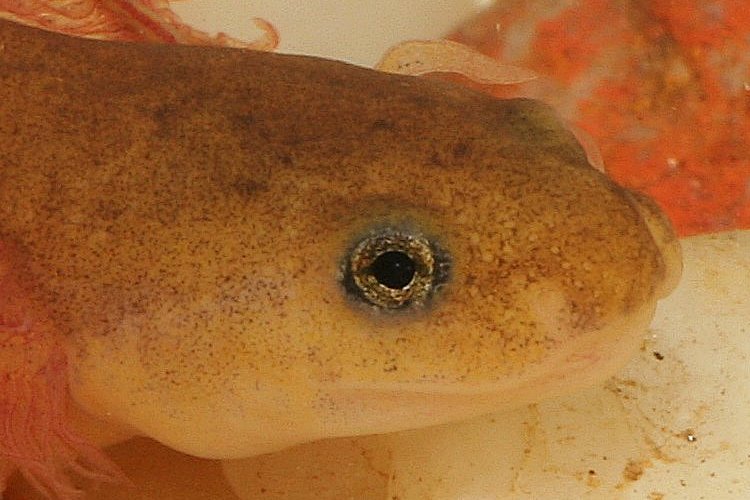
Head of a 66-mm TL Pseudotriton montanus larva. Note the lack
of a distinct horizontal dark bar through the iris.